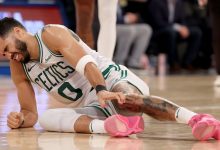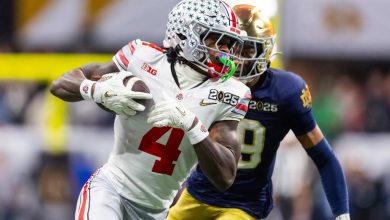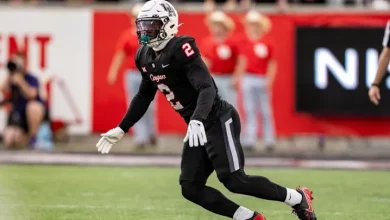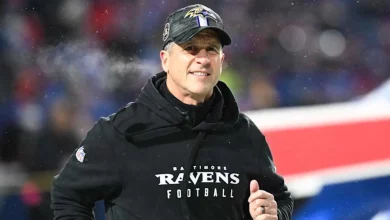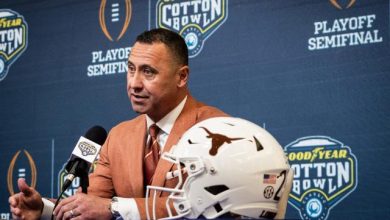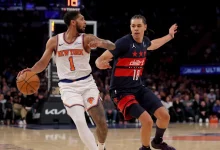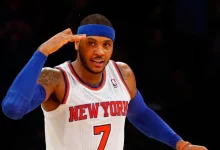Lamar Jackson’s “favorite target” was a surprise trade bait for the Baltimore Ravens.
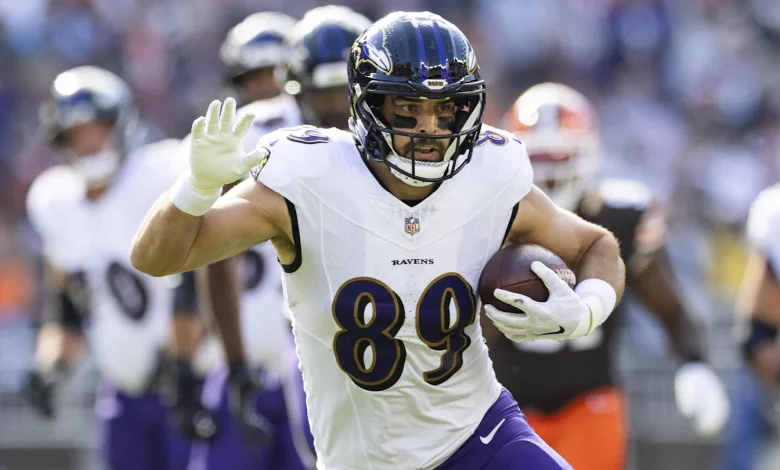
The NFL is a league of constant change, where even the most familiar faces can find themselves in unexpected situations. This truth became evident when the Baltimore Ravens, under general manager Eric DeCosta and head coach John Harbaugh, made the surprising decision to place one of Lamar Jackson’s most trusted and reliable targets, wide receiver Marquise “Hollywood” Brown, on the trade block during the 2022 NFL Draft. Brown, a key weapon in Jackson’s offensive arsenal, was widely regarded as the Ravens’ top receiving threat, and his departure raised more than a few eyebrows in the football community.
The decision to move Brown, a first-round pick in the 2019 NFL Draft, was perplexing on several fronts. It wasn’t just that Brown had established himself as one of Jackson’s favorite targets, but also because it came at a time when the Ravens were in the midst of a wide receiver crisis. The Ravens had long been criticized for their inability to surround Jackson with elite pass-catching talent. With Brown’s departure, many questioned how the Ravens could continue to build an offense around the former MVP quarterback. In this article, we’ll examine the circumstances surrounding Brown’s trade, the impact it had on both Lamar Jackson and the Ravens, and the broader implications it had for the franchise’s future.
Marquise “Hollywood” Brown’s Journey to Baltimore
Before we dive into the trade itself, it’s important to understand the relationship between Lamar Jackson and Marquise Brown. The two had a special bond on the field, forged through their shared history and complementary skill sets. Brown, a speedster out of the University of Oklahoma, was drafted by the Ravens as the 25th overall pick in the 2019 NFL Draft, with the expectation that he would be the deep threat Jackson desperately needed. Despite being undersized (standing at 5’9” and weighing 166 pounds), Brown showcased blazing speed and exceptional route running that allowed him to stretch the field.
During his first three seasons in the NFL, Brown was a consistent performer for the Ravens. In his rookie year, he caught 46 passes for 584 yards and seven touchdowns, and while his numbers didn’t blow the league away, he was a key part of an offense that dominated on the ground with Jackson at the helm. Over the next two seasons, Brown continued to develop chemistry with Jackson, particularly on deep passes, where his speed was a constant threat.
In 2021, Brown’s numbers took a noticeable leap. He finished the season with 91 receptions for 1,008 yards and six touchdowns, making him the first Ravens wide receiver to break 1,000 yards in a single season since Anquan Boldin in 2012. Jackson, who had been struggling with injuries in the latter half of the season, still leaned heavily on Brown as his primary receiving weapon. The connection between the two was evident, and many believed that as long as Brown remained in Baltimore, Jackson would always have a deep threat to keep defenses honest.
The Shocking Trade
In April 2022, just days before the NFL Draft, the Ravens made the stunning decision to trade Marquise Brown to the Arizona Cardinals in exchange for the 23rd overall pick in the 2022 Draft and a third-round pick (No. 100 overall). The trade sent shockwaves through the NFL world, and the fallout was immediate. Brown was one of the few bright spots in a receiving corps that had long been considered underwhelming, and many were left wondering why the Ravens would part with a player who had such clear chemistry with their star quarterback.
One of the most striking aspects of the trade was that it seemed to come out of nowhere. There had been no prior indication that Brown was unhappy in Baltimore or that the Ravens were actively shopping him. While there had been rumors about the team looking to add more weapons to their passing game, the idea of trading away one of their top players—particularly someone who had developed such a strong rapport with Jackson—was not a move that anyone saw coming.
So why did the Ravens make such a move?
Contract Concerns
One of the primary reasons for the trade was financial. Marquise Brown was entering the final year of his rookie contract, and the Ravens were facing a potential contract extension negotiation. While Brown had shown flashes of brilliance, his consistency had been questioned, especially in the Ravens’ offense, which leaned heavily on the running game and often struggled to establish a rhythm in the passing attack.
In a league where wide receivers are increasingly demanding top-tier money, the Ravens may have been hesitant to commit a long-term contract to Brown. The team had to weigh the cost of keeping him against the potential benefit of using his trade value to address other needs. The 2022 NFL Draft was considered to have a deep class of wide receivers, and the Ravens may have felt that they could find a similar player at a lower cost.
A Different Vision for the Offense
Another factor in the trade may have been the Ravens’ evolving vision for their offense. Under offensive coordinator Greg Roman, the Ravens had been known for their run-heavy attack, built around Lamar Jackson’s unique skill set as a mobile quarterback. However, as the league continued to evolve, there was growing pressure for the Ravens to become a more balanced offense. Trading Brown could have been a signal that the Ravens were preparing to shift their offensive philosophy, potentially moving away from relying so heavily on one player and instead diversifying their passing game.
This shift in philosophy became more evident when the Ravens drafted wide receiver Rashod Bateman in the first round of the 2021 Draft. Bateman, a talented and well-rounded receiver, was viewed as a more complete threat than Brown. The addition of Bateman, coupled with the Ravens’ continued commitment to their running game, suggested that the team was looking to build a more diversified offense, rather than depending on one player to be the focal point of their passing attack.
The Lamar Jackson Factor
Of course, one of the biggest questions following the trade was how it would affect Lamar Jackson. The quarterback and Brown had developed a strong rapport over the previous seasons, and the trade left Jackson without one of his most reliable weapons. While Jackson had always been more of a dual-threat quarterback—capable of making plays with his legs as well as his arm—the absence of Brown forced him to adjust to a new set of receiving options.
The trade raised concerns about Jackson’s ability to continue his MVP-level performance without a clear deep threat in the lineup. The Ravens still had Bateman, who had shown promise as a rookie, and veteran wide receiver Devin Duvernay, but neither of them had the same explosive playmaking ability as Brown. Additionally, the Ravens’ tight ends, Mark Andrews and Nick Boyle, had been key targets for Jackson, but they were more reliable in intermediate and short-yardage situations than as deep threats.
In many ways, the trade of Brown mirrored a broader issue facing the Ravens’ offense. The team had failed to consistently build around Jackson, despite his success on the field. Jackson had been named MVP in 2019, but the team had struggled to give him the necessary pieces to succeed in the postseason. Brown’s trade was a reminder of how difficult it could be for Jackson to thrive in a system that didn’t prioritize the development of elite pass-catching talent.
The Aftermath of the Trade
In the months following the trade, the Ravens’ decision to move on from Brown was met with mixed reactions. Some analysts defended the move, arguing that the Ravens were simply doing what they felt was best for the future of the team. With the influx of draft picks and the potential to add new weapons in the passing game, the team’s long-term outlook remained strong. Others, however, were more critical, arguing that the trade was a mistake and that the Ravens had weakened their offense at a time when Jackson’s future with the team was uncertain.
For Jackson, the trade left him in an unfamiliar position. He had always thrived with Brown as a deep threat, and the loss of that weapon required him to adapt his game further. Jackson would need to rely more heavily on Bateman, Duvernay, and Andrews to carry the passing game, all while continuing to be the focal point of the Ravens’ rushing attack.
The Ravens did attempt to add new weapons to the offense, signing veteran wide receiver DeSean Jackson and drafting Zay Flowers in the first round of the 2023 Draft. However, many still felt that the Ravens had missed an opportunity to truly build around Jackson with a top-tier wide receiver corps.


